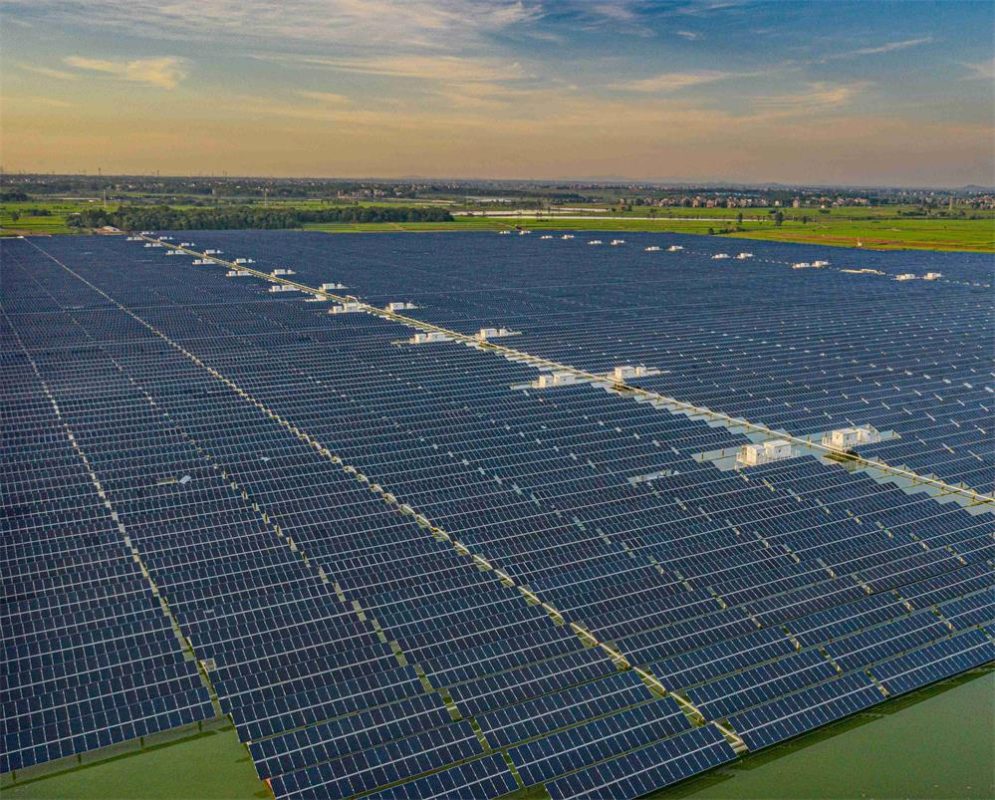Z ciągłą popularyzacją i rozwojem nowej energii, more and more industrial and commercial enterprises, commercial entities and individual house users are aware of the environmental and economic benefits of solar energy. With the rapid progress made in solar photovoltaic technology over the years, new technologies are constantly appearing on the market. There are currently three main types of solar photovoltaic modules produced from different types of raw materials on the market:
1. Monokrystaliczny
2. Polikrystaliczny
3. Cienka folia

Monokrystaliczny Solar Panels
Monocrystalline solar panels are now the most popular type of solar panel module due to their power output and efficiency. Usually the efficiency of monocrystalline solar panels can exceed 20%. The current mainstream processes are Perc and N-type, among which N-type modules will become the main force in the future market! Photovoltaic modules with N-type topcon technology are currently the main technical direction in which major manufacturers have increased investment. W tym samym czasie, leading companies in the photovoltaic industry are increasing their research and development efforts. Their R&D personnel are working on developing more efficient solar modules and using technological innovation to occupy new market heights.
Panel cell color is one of the easiest ways to identify monocrystalline solar panels. Due to the interaction of light with its high-quality monocrystalline silicon, the module’s cells typically appear black to the naked eye, allowing it to perform well in low-light environments. Dlatego, they are more efficient since black surfaces absorb light easily. They also tend to produce more power than other types of panels, not only because of their efficiency, but also because they feature modules with power capacities in excess of 500 waty. Most people prefer the sleek look of completely black monocrystalline solar modules on their roofs as they blend well with black roof tiles.
Polikrystaliczny Solar Panels
Polycrystalline solar panels have been around for quite some time and are favored by many people on a budget. Typowo, the efficiency of these solar panels ranges from 15% Do 17%. Although they are less efficient than their monocrystalline silicon counterparts, their lower cost is an advantage. The reason for this is that the cells are made up of multiple silicon fragments, hence the name “polysilicon,” rather than the single pure silicon crystal used in monocrystalline cells. This simplifies the battery manufacturing process and provides a more cost-effective product to the end customer.
Compared with monocrystalline panels, the easiest thing to distinguish polycrystalline panels from is their color. The cell color of polycrystalline silicon photovoltaic panels is produced by an anti-reflective coating that enhances the solar panel’s absorption capacity and efficiency, giving the product a blue appearance on its surface.
Thin Film Słoneczny Panels
Thin-film solar panels are often less efficient and have lower power capacity than monocrystalline and polycrystalline panels. Despite the fact that the efficiency of solar cells might vary depending on the material used to construct them, they typically have an efficiency of around 11%. In order to produce the same amount of energy as a monocrystalline or polycrystalline solar system, more thin film solar panels would need to be put if their efficiencies were lower. Thin-film solar panels may not be the greatest option for residential solar for this reason. Jednakże, they make the greatest sense in larger installations, such as utility-scale solar projects, where more panels may be put to meet energy needs.
Thin film solar panels are comprised of solar cells with light-absorbing layers that are around 350 times thinner than the average silicon panel, rendering them extremely flexible. Depending on their composition, they are available in blue and black tones. The most common type of thin film solar panel is cadmium telluride, but they can also be created from amorphous silicon, which is comparable to the composition of monocrystalline and polycrystalline panels, and copper indium gallium selenide. The cost of thin film solar panels mostly depends on the material from which they are formed, however the installation of thin film solar panels is typically less expensive than monocrystalline or polycrystalline systems.

Explanation of the Composition of the Many Varieties of Solar Panels
The first type is the monocrystalline solar panel, which consists of many wafers cut from a single piece of pure silicon. Pure silicon is the optimal crystal form, which provides monocrystalline panels with superior durability and space efficiency. Jednakże, the disadvantage is that the manufacturing process often employs pure silicon. W rezultacie, monocrystalline solar panels are more expensive than polycrystalline solar panels.
W przeciwieństwie, polycrystalline panels are comprised of a number of distinct silicon crystals. They are subsequently fused into a single panel. The primary advantage of this method is that no silicon is lost, hence keeping costs reasonably low. But there is a cost. The energy efficiency and heat resistance of polycrystalline panels are much lower than those of monocrystalline panels. Zatem, they generate less energy overall.
W końcu, thin-film solar panels are composed of wholly different materials. Typowo, copper indium gallium selenide (CIGS), amorficzny krzem (a-SI), or cadmium telluride are employed (CdTe). A-SI is typically the least expensive and least efficient of the three varieties, while CIGS is typically the most efficient.
What is the Capacity of Every Individual Solar Panel?
Due to higher efficiency per square foot, monocrystalline silicon panels have the greatest output and power capacity. Obecnie, the power of mainstream solar panels ranges from 400W to 700W. Polycrystalline panels are surprisingly close behind, with average power outputs of panels ranging from 200W to 400W.
W przeciwieństwie, the capacity of thin-film panels is more difficult to generalize due to their varying sizes. Jednakże, ogólnie mówiąc, they produce less power than crystalline silicon PV panels, typically between 200-300W.
What is the Efficiency Depending on the Type of Solar Panel?
Above 21%, monocrystalline panels offer the best efficiency rating of all solar panel types. To oznacza, że 21% of solar energy can be converted into useable energy. The efficiency of polycrystalline panels falls within the usual range, między 18% Do 23%. These numbers would adequate for most residential applications.
W przeciwieństwie, thin-film panels have a higher overall efficiency rating than silicon crystalline panels. CIGS, the finest of the three, is the highest at 13% Do 15%. CdTe ranges between 9% I 11%. a-SI has the lowest efficiency, od 6% Do 8%, which is why it is commonly employed in low-power applications such as solar calculators.
How much do the three distinct solar panels cost?
Because to their energy and space efficiency, monocrystalline panels are the most expensive. Its price per watt ranges from $1 Do $1.20, therefore a 500 watts panel will cost between $500 I $600.
Polycrystalline panels have a great cost-to-performance ratio. They cost between $0.90 I $1 na wat, Lub $315 Do $350 dla 350 watts panel. It may not seem like a substantial discount, but when purchasing 20 or more panels, the savings mount up.
The price range for thin-film panels is between $0.50 I $1 na wat. CIGS is often priced at the upper end of this spectrum.

Which Solar Panel Type Is the Best?
Many parameters, such as the size and weight of roofs, determine which solar panel type is ideal for your needs. If you have limited space or require high efficiency per square foot to save money, monocrystalline solar panels are ideal.
If you own a larger property, such as a business building or a farm, the opposite is true. At a sufficient area, the decreased efficiency of a polycrystalline panel can be compensated for by lower installation costs, allowing you to install more panels to make up for the output loss.
When a crystalline silicon panel is impractical, thin-film panels are a viable option. Examples are the thin roofs of buildings and the tiny tops of RVs. With a greater temperature coefficient, they are also excellent choices for hotter conditions (more on this later).
Notatka, Jednakże, that the cost of the panel itself is not the sole consideration. To get a clear picture of which type is ideal for you, you need also consider labor and maintenance expenditures.
Variables Influencing Solar Panel Models
The ability of a solar panel to withstand heat is one of the primary factors that can affect its efficiency. This is measured by the temperature coefficient of the panel or the decrease in output per degree of temperature increase. Thin-film panels have an output loss of only 0.2%, but crystalline panels lose between 0.3% I 0.5% ich mocy.
Ponadto, weather resistance is a key factor. In colder climates, hail resistance is particularly crucial. Ogólnie, crystalline panels are more resistant to hail damage than thin-film panels. You should also be wary of light-induced degradation, or LID. This phenomenon causes a short decrease in performance during the first few hours of exposure to sunshine as a result of oxygen from the manufacturing process. Typowo, to jest pomiędzy 1% I 3% output loss.
